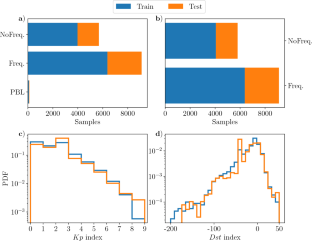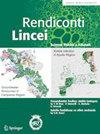在地球等离子层的场线共振频率的自动检测
IF 2.7
4区 综合性期刊
Q2 MULTIDISCIPLINARY SCIENCES
引用次数: 0
摘要
地面磁力计站是一个多视点和易于访问的系统,用于探测地球磁场内部磁层的扰动。利用对经向排列的台站记录的超低频(ULF)测量,可以确定与赤道磁层等离子体质量密度直接相关的场线共振(FLR)频率。最近,Foldes等人证明了这一点[J] .地球物理学报,26(5):e2020JA029008。https://doi.org/10.1029/2020JA029008, 2021),机器学习(ML)算法是通过利用交叉相位傅立叶光谱提供的有用信息来检测flr的有价值的工具,这是推断磁层质量密度的ULF技术的核心。这种方法的主要缺点是无法根据共振区分活跃时间和安静时间。众所周知,由于数据间隙、噪声信号和/或静态ULF波周期,使用交叉相位光谱检测flr通常是不可行的。为了处理这些情况,我们实现了一个ML分类算法来识别共振频率可观察到的周期,从而容易估计。我们的算法可以将样本分为三大类:具有观测频率的周期(“Freq”类)和其他周期(“NoFreq”类),此外,它还可以确定在给定时间考虑的场线是否越过等离子层边界层(PBL或plasmapause)。利用包含不同地磁条件的大型数据集,在赤道准子午磁强计阵列(EMMA)沿线的一对特定台站($$L=2.9$$)上验证了我们的方法的结果。该方法可以与Foldes等人提出的回归算法(例如,地球物理学报,126(5):e2020JA029008)相结合。https://doi.org/10.1029/2020JA029008, 2021))在一个两阶段的ML管道中,其最终目标是实现一个完全自动化的系统,用于从地面磁力计站实时监测等离子体层动力学。本文章由计算机程序翻译,如有差异,请以英文原文为准。

Automatic detection of field line resonance frequencies in the Earth’s plasmasphere
Ground-based magnetometer stations represent a multi-viewpoint and easy-to-access system for sounding Earth’s magnetic field disturbances in the inner magnetosphere. Using Ultra-Low Frequency (ULF) measurements recorded from pairs of meridionally aligned stations, it is possible to determine the Field Line Resonance (FLR) frequencies, which are directly related to the equatorial magnetospheric plasma mass density. Recently, it has been shown by Foldes et al. (J Geophys Res 126(5):e2020JA029008. https://doi.org/10.1029/2020JA029008 , 2021) that the Machine Learning (ML) algorithms are valuable tools for detecting FLRs by exploiting the useful information provided by cross-phase Fourier spectra, which are at the heart of the ULF technique for inferring the magnetospheric mass density. The main shortcoming of this approach is that it is not possible to discriminate between active and quiet times in terms of resonances. It is commonly known that detecting FLRs using cross-phase spectra may often be unfeasible due to data gaps, noisy signals, and/or quiescent ULF wave periods. To handle these situations, we implement an ML classification algorithm to identify periods when the resonance frequencies are observable and thus easily estimated. Our algorithm can distinguish samples into three main classes: periods with observed frequency (“Freq" class) from others (“NoFreq"), and, in addition, it can determine whether the considered field line crosses the plasmasphere boundary layer (PBL or plasmapause) at a given time. The results of our method are validated for a particular pair of stations (at $$L=2.9$$ ) along the Equatorial quasi-Meridional Magnetometer Array (EMMA), using a large dataset comprising different geomagnetic conditions. The proposed approach might be combined with a regression algorithm (such as those proposed in Foldes et al. (J Geophys Res 126(5):e2020JA029008. https://doi.org/10.1029/2020JA029008 , 2021)) in a two-stage ML pipeline, with the ultimate goal of implementing a completely automated system for the real-time monitoring of the plasmasphere dynamics from ground-based magnetometer stations.
求助全文
通过发布文献求助,成功后即可免费获取论文全文。
去求助
来源期刊

Rendiconti Lincei-Scienze Fisiche E Naturali
MULTIDISCIPLINARY SCIENCES-
CiteScore
4.10
自引率
10.00%
发文量
70
审稿时长
>12 weeks
期刊介绍:
Rendiconti is the interdisciplinary scientific journal of the Accademia dei Lincei, the Italian National Academy, situated in Rome, which publishes original articles in the fi elds of geosciences, envi ronmental sciences, and biological and biomedi cal sciences. Particular interest is accorded to papers dealing with modern trends in the natural sciences, with interdisciplinary relationships and with the roots and historical development of these disciplines.
 求助内容:
求助内容: 应助结果提醒方式:
应助结果提醒方式:


